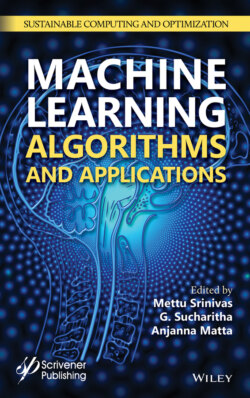Читать книгу Machine Learning Algorithms and Applications - Группа авторов - Страница 33
2.3.2 Foreground-Background Segmentation
ОглавлениеThe basic requirement for accurate counting of silkworm egg is to perform foreground-background (FB) segmentation. In the previous attempts, the background was segmented based on the intensity value of the eggs [8]. The region that has no pixel values corresponding to the eggs is considered as background and discarded before the image processing stage. However, this is not ideal in all situations, since the silkworm eggs laid on the sheet may also contain urine from the silkworms that discolor the background. The urinated background dries into a white layer that resembles an egg pixel intensity value close to 230 for an 8-bit grayscale image.
The resolution of the digital data that is fed into the CNN model is another reason to perform segment the background before the class of eggs is determined. The eggs are of the size around 32 × 32 pixels after scanning, while the entire sheet of silkworm eggs is of the size 5008 × 6984 pixels (in our experiment). If the entire sheet was fed to the CNN model with an input image size of 32 × 32 pixels with a sliding window method, then the model must classify 35M images that would be computationally expensive for a system without GPU support.
To overcome this issue, the FB CNN model was trained with an input data of 128 × 128 pixels, three-channel RGB image that was fed to the core CNN model, as shown in Figure 2.3, to provide categorical output using the softmax activation function. Some of the corresponding specifications of the FB CNN model are provided in Table 2.1 along with accuracy scores. Using a 128 × 128 pixel input to the FB CNN model, the entire silkworm egg sheet is divided into square grids of 128 × 128 with a stride of 128, resulting in an image set of 2K images that must be processed for categorical results as foreground or background class. Figure 2.4 represents the segmentation of the entire silkworm egg sheet, where the foreground (presence of egg) and background (absence of egg) are represented by a green color (pixels) and red color, respectively. Further processing is only carried out for pixels represented in green color that minimizes computational time and increase final accuracy as background pixels are dropped out of the data processing cycle.
Table 2.1 Specifications of foreground-background (FB) segmentation CNN model.
| Input image | Activation/output | Training samples | Test samples | Validation samples | Test loss | Accuracy on the test set | Accuracy on the validation set |
| 128 × 128 | SoftMax 2 class-(0/1) | 142 × 103 | 64.3 × 103 | 9.6 × 103 | 0.1242 | 96.1554% | 96.6422% |
Figure 2.4 Foreground-background segmentation of entire silkworm egg sheet (a) (input) and (b) (output).
